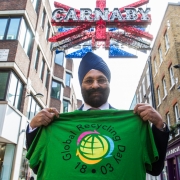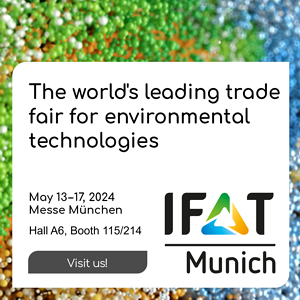China‘s Import Ban: A Drama for the Recycling Branch?
Several times China has complained about the quality of imported waste. However, the lately implemented ban seems to be a surprise to the waste exporting businesses.
Surendra Patawari Borad, Chairman of plastics committee at the Bureau of International Recycling (BIR), once said about Europe and the U.S.: “If China gets a cold, we get a fever, and if China gets a fever, we get pneumonia.” Only recently the recycling branch coughs. Since the first of January 2018, the Chinese Government applies new import rules banning the import of 24 grades of 0.5 percent contaminated solid waste of most scrap, for the moment mainly mixed papers and post-consumer plastic, and one percent for non-ferrous scrap. That was a shock for most of the affected exporting nations. But the reactions of their branches differ.
USA: The world’s largest waste importer to China
For the U.S. industry, the Chinese import ban came hard, but not fast. As the U.S.- China Economic and Security Review Commission carved out, U.S. waste and scrap exports to China peaked at 11.6 billion US-Dollar in 2011 before declining to 5.2 billion US-Dollar by 2016 – “largely due to Chinese concerns over waste and scrap contamination and a Chinese inspection crackdown”. But of course, the ban – and already its announcement – had and will have a negative economic impact on the recycling industries in the United States as the world’s largest exporter of waste and scrap and largest waste and scrap importer to China. According to figures of the National Waste & Recycling Association (NWRA), in 2016 approximately 41 percent of paper recovered in the North Americas was exported with about a quarter of recyclable paper and in 2015 more than 20 percent of post-consumer bottles and 33 percent of non-bottle rigid plastics.
The cut did not come surprisingly. However, “the industry was not prepared for it,” said Surendra Patawari Borad, member of Brussels-based Bureau of International Recycling. The NWRA as much as the Institute of Scrap Recycling Industries (ISRI) and the Solid Waste Association of North America’s (SWANA) were “disappointed the Chinese government did not modify its waste import restrictions in response to the serious concerns raised by North American, European and Asian governmental authorities and associations”. And sentenced the restrictions as “extraordinary” and “already adversely impacting recycling programs throughout North America”. More than that, they counteracted what SWANA called “substantial changes to their operations” of many American and Canadian companies and local governments in late 2017 and 2018. These changes, SWANA reported in September 2017, saw many material recovery facilities looking to upgrade their sorting systems to improve the quality of their bales along with better educating their residents.
Stockpiled or landfilled
That was not the only way the North American recycling branch took action. Some of the exports were diverted. Vermont based Casella Waste Systems for example provides about 25 percent of its fiber typically going to China since recently to India, Indonesia, Thailand and Korea and new domestic buyers. And a spokesperson of the Suez Group Recycling conceded the export of materials directly to China in April 2017 and the securing of alternative offtake markets in Europe and Asia. Several amounts of former exports were stockpiled temporarily. In Nova Scotia, the Halifax Regional Municipality is temporary allowed to send low-density plastics to a private landfill. The Rogue Disposal & Recycling’s facility in Oregon was forced to put recyclables like mixed paper, cardboard and plastics into interim storage at their employee parking lot. And David Biderman, SWANA Executive Director and CEO, noted “recyclables are going to landfills in Oregon, to waste-to-energy facilities in Massachusetts, and being stored in warehouses and parking lots in the U.S. and Canada.” Still in December 2017, Ranjit Baxi, president of the Bureau of International Recycling, appealed: “If it doesn’t go to China for two to three months, you’ll have one million tons of paper stacked somewhere in the American economy.” But the branch looks forward too. Casella Waste Systems has invested in some more polishing separators, added labor force to capture contaminants by hand and asked customers to improve waste quality. The Oregon Refuse and Recycling Association argued: “Markets in China and elsewhere remain for higher grade recyclables and recycled commodities. The ban presents both an opportunity and a necessity to review curbside recycling programs and improve their quality.” Patty Moore, executive director of the Plastic Recycling Corporation of California, considered that the long-term need is to increase domestic processing in the United States. And likewise, The Recycling Partnership, a national recycling nonprofit, is sure that China’s National Sword policy poses a problem, “but it is also an opportunity. An opportunity to diversify market options. To refocus on quality. To support jobs in U.S. recycling. To grow U.S. manufacturing. What can you do? Keep calm, stay informed and focus on clean material.”
UK: Securing alternative offtake markets
In 2016, the United Kingdom exported 55 percent of recovered plastics and 74 percent of exported paper to China. So the import ban means not only a future “lot of uncertainty”, like Adam Read, external affairs director at waste management company Suez, judged. It is “an impending crisis”, caused as well by lacking of a clear UK recycling and waste strategy, a shortage of domestic capacity to recycle and an uncertainty caused by Brexit, Adam Read was quoted by Greenpeace’s online-journal Unearthed. Following the papers, the import ban had consequences: The Guardian referred to some industry experts who already saw “a buildup of rubbish at recycling plants around the UK”. And The Telegraph related to statements of officials warning that “hundreds of thousands of tons of toxic plastic could be burnt in Britain rather than recycled” due to the import ban. The industry reacted in their own way: Official data for the third quarter of 2017 showed increases in exports of plastics to Turkey, Taiwan, Vietnam and Malaysia and increases in exports of paper to Turkey, Taiwan and Vietnam. And a spokesman of SUEZ Recycling and Recovery UK acknowledged that the company completed exports to China already in April 2017 and secured alternative offtake markets in Europe and Asia.
Of course, the Chinese import ban will have a serious domestic impact on the UK recycling supply chain, the Resource Association stated. But its Chief Executive, Ray Georgeson, remained realistic: “We must now use this moment to seize the opportunity it should present to rebalance the UK recycling economy and return to the unfinished tasks of developing our own markets and sustainable end uses for our secondary materials.” The balance of responsibility for plastic products placed on the market must also shift towards producers, through design for recyclability and minimum recycled content, he believed. Therefore, he proposed a regulatory approach including mandatory design guidelines and mandatory recycled content for various plastic products, trading standards to ban certain single-use plastic products and investment in manufacturing technology to support the use of recyclate as a primary input. This would have been necessary anyhow: The Resource Association estimates the annual cost of contamination to UK re-processors associated with the management of poor and inconsistent quality recyclate by its re-processor members of 51 million Pound Sterling (57 million Euro).
The politics sprang into action
The official policy was criticized. Recycling Association‘s Chief Executive Simon Ellin grumbled: “It is very disappointing that Michael Gove is not aware of the fundamental impacts that China‘s ban will bring to the UK‘s recycling and waste industry.” Environment State Secretary Michael Gove had admitted on the first of November: „I don‘t know what impact it will have […] and to be honest, I haven‘t given it sufficient thought.“
The criticism was fruitful. On the 18th of December 2017 Michael Gove announced a “four-point plan for tackling plastic waste” including cutting the total amount of plastic in circulation, reducing the number of different plastics in use, improve the rate of recycling and making recycling easier. Furthermore, a call for evidence around deposit reward and return schemes for plastic bottles and other drinks containers was launched. And he told the BBC that in the short term the UK would look to other East Asian nations to recycle British waste. But in the longer term the nation must “stop offshoring our dirt”. The Environment Agency issued fresh guidance to exporters, stating that any waste which does not meet China’s new criteria will be stopped, in the same way as banned waste going to any other country.
A desire to tackle the challenges
On the 11th of January 2018, Prime Minister Theresa May committed the UK to eliminating avoidable plastic waste by 2042 – with the reservation: “Avoidable means what is technically, environmentally and economically practicable.” The long-awaited 25 Year Environment Plan schedules among others comprehensive measures for production, consumption and recycling. On the very same day and as part of the Environment Plan, Waste Resources & Action Programme (WRAP) in partnership with the Ellen MacArthur Foundation announced a new and unique UK collaborative initiative to “help turn the tide on the UK’s growing issue of plastic waste”. The ambitious gathering wants to involve collaborative action and commitment by businesses, industry, governments, local authorities, NGOs, media and society at large, to re-define what is possible and create a plastic system that works – according to WRAP “a circular economy where plastic is valued and never becomes waste”.
“When it comes to the recycling, resources and waste elements of this plan, we’ve been talking about driving improvements for many years,” Simon Ellin commented. “It’s good that there now appears to be an understanding of the challenges and a desire to tackle them.” This corresponded to Ray Georgeson’s call to the Government “to stimulate secondary markets in the UK for plastic waste and increase producer responsibility for plastic products placed on the UK market”. Or – as he explained at another place – to rebalance the UK recycling economy and develop domestic markets and sustainable end uses for secondary materials of improved quality.
Malaysia: Imports multiplied
Already in 2017, shipments of waste to South Asia have tremendously grown. According to ISRI figures for 2016 to 2017, Malaysia nearly quadrupled its imports of mixed or other plastic solely from USA within a year. BIR estimates that the country increased its entire plastic scrap imports from 288,000 tons in 2016 to 450,000 – 500,000 tons in 2017. Plastic scrap imports to Thailand expanded by 117 percent, to Indonesia by 65 percent and to Vietnam by 62 percent. Mixed waste imports to Malaysia and to Thailand even rose by 292 and 150 percent respectively. Other data indicate the increase of PET imports of 63 percent and of PVC imports by more than 400 percent to Malaysia. PE waste shipped to Thailand ascended between 2016 and 2017 by 876 percent. And even India showed increasing imports by 50 percent for PE, a larger growth in volume than that of any other country.
Data from IHS Markit indicate that the previous import capacities of other countries for processing U.S. waste exports were single-digit: India as the second-largest acceptor shared 7.9 percent, South Korea 4.4 percent, Indonesia 2.1 percent, and Taiwan 1.3 percent. Hence, the Financial Post presumed: “Countries including India, Thailand, Vietnam, Taiwan and South Korea could import more mixed paper, but they probably couldn’t make up for what’s being lost from China.” Or as one of ISRI`s senior directors, Adina Renee Adler, expressed it: “China’s demand was greater than the next ten markets combined. Not one country can make up that volume.”
Do not turn Malaysia into a landfill
But it is not only the quantity, that raises questions. The quality of imported waste in South Asia is as well disputable. In July 2017, the Harakah Daily published that at Malaysian seaport Port Klang 800 abandoned containers carrying contaminated waste were stockpiled, imported mostly from United Kingdom, the United States, Germany and Japan; clearing cost: five million Euro. The Penang Consumer group found this procedure endemic at other Malaysian ports and advised that such imports should be banned to prevent Malaysia becoming a dumping ground for other countries’ waste. In November 2017, The Daily Sun interviewed Malaysia’s Urban Wellbeing, Housing and Local Government Minister Tan Sri Noh Omar. He spoke of detained containers transporting prohibited solid wastes, reported that several importing companies had failed to comply with the regulations regarding plastic wastes, and mentioned that the responsible department had been instructed to review on the issuance of approved permits to 149 plastic waste importing companies – delivering waste from countries including China, Hong Kong and Singapore. The minister verbally: “Do not turn Malaysia into a landfill and do not manipulate the rules for quick profits. This act will not be forgiven.”
This trend is verified by Pablo Leon from his point of view. In early January 2018, the manager for Spanish recovered plastics broker Fosimpe was cited with the words: “For now, we are mostly focusing on Southeast Asia for our exports […] We are changing our whole strategy.”
“Europe is now at crossroads”
Facing these circumstances, the waste exporting nations have to decide their future behavior. According to Zero Waste Europe, “Europe is now at crossroads with two main solutions ahead. The first one is to continue with business as usual, producing increasing amounts of low quality plastics and finding new markets where we can get rid of them while we consider whatever happens abroad as ‘recycling‘. This will work until these countries follow China’s path and decide to stop being the world’s landfill. The second option is to tackle plastic waste at source, with ambitious plastic prevention and reuse targets and increase capacity for recycling in Europe. Although it requires courage and significant systemic change of our consumption and production patterns, this is, by far, the best and only long-term solution and, even better, it is good for the people, good for the planet and good for the economy.”
Photo: pixabay
GR 12018









